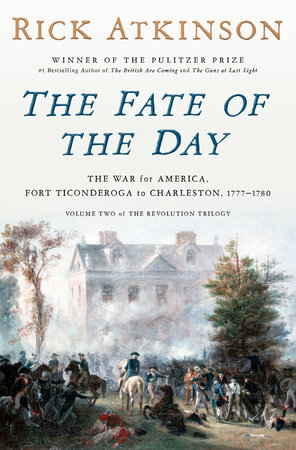1.The March of AnnihilationFort Ticonderoga, New York, July–August 1777A rattle of drums at four a.m. on July 1, 1777, roused the British encampment at Crown Point, on the western lip of Lake Champlain. Soldiers stumbled from their tents, shrugged on their uniform coats, and gobbled down a cold breakfast with the indifference of men who expected no better. For the past fortnight the invasion force of eight thousand troops had sailed and rowed south for a hundred miles, from the Richelieu River in Quebec to within fifteen miles of the American stronghold at Fort Ticonderoga. Through mischance and rebel defiance, many of these same redcoats had failed to capture the fortress eight months earlier, despite standing at the gates. Now the prize again lay within grasp, and this time they intended to win through. “We are to contend for the king and the constitution of Great Britain, to vindicate law and to relieve the oppressed,” orders issued the previous evening proclaimed. “This army must not retreat.”
By five a.m., the sun had crested the great shoulders of the Green Mountains to the east, gilding the craggy Adirondacks in the west. Platoon after platoon scuffed down to the shoreline to clamber aboard gunboats, longboats, and six-oared, flat-bottomed bateaux. Shouted orders carried across the lake, along with the creak of capstans and oarlocks. Soon the first vessels pulled away from the anchorage, to assemble mid-lake in battle formation. Army musicians caught the moment and struck up martial airs. “The music and drums of the different regiments were continually playing,” a Royal Artillery lieutenant wrote, “and contributed to make the scene and passage extremely pleasant.”
More than a hundred birch-bark canoes led the flotilla. Each carried twenty to thirty warriors, mostly Iroquois sporting nose rings, slitted earlobes, and feathers in tufted topknots, their eyelids and cheeks daubed with vermilion paint. Some wore knife sheaths made from lynx skins and, a British officer recorded, an “arse clout, or covering for the privities.”
Arrayed across the mile-wide lake behind the Indian vanguard came the main battle force, “the most complete and splendid regatta you can possibly conceive,” a witness reported: the three-masted frigate Royal George, built by shipwrights in Canada during the winter and carrying 26 guns, and smaller vessels named Inflexible, Carleton, Maria, and Royal Convert, as well as 44 gunboats, 23 longboats, 26 cutters, 260 bateaux, and a wallowing ninety-one-foot radeau, or raft, the Thunderer, ferrying barreled gunpowder and heavy cannons intended to blast Ticonderoga’s walls to rubble. A brig, a gundalow, and a sloop—Washington, Jersey, and Lee—had been captured in October from the rebel general turned commodore Benedict Arnold, whose gallant, forlorn rearguard fight in these very waters had helped delay the earlier British attack until winter forced the invaders back to Canada. All told, this squadron carried 133 naval guns to complement the army’s 130 field cannons, mortars, and howitzers, each barrel stamped with the king’s monogram or other symbols of possession. Storeships and lake transports continued to arrive at Crown Point from the north, laden with almost five thousand tons of salt pork, hard biscuits, and other rations, along with siege tools, ammunition, rum, cattle, and civilian camp followers, whose numbers officially included 225 women and 500 children, although some hyperbolists would claim that the combined figure actually approached two thousand.
“It looked,” wrote Corporal Roger Lamb of the 9th Regiment of Foot, “like some stupendous fairy scene of a dream.” By late afternoon, many troops had disembarked on either shore to join the advance regiments moving toward Ticonderoga, now just a few miles ahead. Bullfrogs croaked in the shallows, and white elderberry blossoms brightened the conifer thickets, “the birthplace of every biting insect,” one miserable chaplain wrote. Some men smeared cedar sap on their faces in a vain effort to repel mosquitoes and deerflies.
On the left, to the east, four thousand mercenaries plodded through the underbrush. Known collectively as Hessians, since most Germans hired by London to fight in America came from Hesse-Kassel, this contingent was largely from the small, impoverished duchy of Brunswick, whose ruling family had intermarried with the British royal family. Brunswick’s duke collected £7 a year for each rented soldier, plus a blood-money bounty for every man killed or captured and an equivalent stipend for every three wounded. The troops earned the same eight pence a day as their British comrades, minus deductions for food and uniforms. Most of the German troops had spent an agreeable winter in isolated bivouacs along the St. Lawrence and Richelieu Rivers, developing a taste for beaver tail, salted sturgeon, and maple sugar.
Jager scouts—professional hunters—led the column, distinctive in their green coats trimmed in crimson and black hats decorated with pompoms. Dragoons followed in leather breeches and woolen gaiters, dismounted for the moment but hopeful of finding American horses ahead. Armed with short carbines and three-foot broad-swords, many cultivated horizontal waxed mustaches and wore their hair in a queue down the back “like a Chinese mandarin,” an admirer wrote. Grenadiers, artillerymen, musicians, gunsmiths, servants, and sutlers filled out the procession, prodded forward by blue-coated officers wearing silver sashes and wielding canes or pointed spontoons. During the voyage down the lake, some men had stripped to the waist to bask in the warm sun and, a surgeon reported, “have been badly sunburned, large blisters developing on their skin.”
The Germans were led by Major General Friedrich Adolph Riedesel. Thirty-nine years old, with a moon face and a ramrod bearing, he had forsaken his law studies in Marburg to take up soldiering, soon demonstrating a hussar’s valor at Minden during the Seven Years’ War. Fluent in French and conversational English, Riedesel considered the opportunity to command in North America to be “sent by Providence.” He had sworn allegiance to George III, like each of his Brunswickers, and had predicted in a dispatch to his duke that “this campaign will finish the war.” Although British officers could be insufferably supercilious toward their German allies, he got on well with the redcoats, even if they stumbled over the pronunciation of his name, calling him “General Red Hazel.”
Those redcoats could now be seen across the lake, moving south in a snaking column parallel to the Germans. Brawny grenadiers, often used to lead assaults, had exchanged their tall bearskin hats for more practical felt caps trimmed in horse-hair. Each foot soldier carried a ten-pound musket, a sixteen-inch bayonet, a tin canteen, a linen haversack, and his own blanket—a battlefield luxury, since in peacetime five men typically shared two blankets. British infantrymen were among the finest soldiers in the world, but most of these troops were green; only the 47th Regiment of Foot had seen extensive combat, at Lexington and Bunker Hill, among other clashes. They were led nonetheless by an exceptional cadre of junior officers, thirty of whom would become generals, including eighteen destined to be full generals, the army’s highest rank. In addition, another six future general officers could be found among the twenty-two Royal Artillery officers in the column.
Squinting at both shorelines through his spyglass from the pitching deck of the Royal George, Lieutenant General John Burgoyne was as pleased with his invasion force as he was with himself. At fifty-four, he had endured a long and arduous climb to high command, and he intended to return to London to claim the laurels owed every victorious commander. Educated at Westminster School, where even mathematics was taught in Latin and boys were birched for the slightest transgression, he had joined the army at fifteen, earned a reputation as both a swordsman and a card sharp, then wrecked his career by eloping with Charlotte Stanley, the youngest daughter of a very angry earl. Effectively banished to France and forced to sell his commission, Burgoyne lived modestly with Charlotte on the Seine for seven years, growing vegetables, traveling the Continent, and making a living at whist and twenty-one.
At last all was forgiven, and a belated reconciliation brought the couple back to England. Burgoyne returned to duty as an aging dragoon captain, just in time to win fame at the cannon’s mouth in the Seven Years’ War, notably in Normandy and Brittany against the French, and on the Tagus River near Lisbon against the Spanish. The king of Portugal gave him a diamond ring in gratitude, and he emerged from the struggle as a British war hero.
Burgoyne’s ascent continued in peacetime. Elected to the House of Commons, he was a diligent, independent military reformer. His insights from an inspection tour of Continental armies impressed George III, as did his parliamentary investigation of East India Company corruption. He and Charlotte shuttled between fine houses in Lancashire and Surrey and on Hertford Street, in tony Mayfair, an easy stroll from the London gambling tables at Brooks’s club. An aspiring playwright, he also became a regular in the Green Room at Drury Lane Theater, where in 1774 the actor and impresario David Garrick directed Burgoyne’s The Maid of the Oaks, a triumphant success.
Copyright © 2025 by Rick Atkinson. All rights reserved. No part of this excerpt may be reproduced or reprinted without permission in writing from the publisher.







